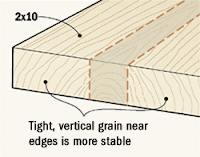It has happened to all of us... You're routing a decorative edge or a round-over on a panel. When you rout with the grain on the sides of the panel everything is fine. But when you rout across the end grain, it looks like your whole project is about to go up in smoke.
Wood burns when it gets too hot (no surprise there), and heat is caused by friction between a cutting tool like a router bit or saw blade and the fibers in the wood.
There are several things you can do to reduce the chance of burning:
1) Always cut with a clean cutting edge -- a cutting edge that's free from pitch (gum) which can increase friction and cause a hotter cut. And the cutter should be sharp. A sharp cutting edge slices the wood fibers, but a dull edge mangles the fibers.
2) Feed the workpiece faster across the cutter. When you feed a workpiece into a cutter at a slow rate, the cutter is making more cuts in the same spot on the board (more than it would at a faster feed rate). This produces a great deal of heat because the cutter isn't just cutting -- now it rubbing or burnishing the wood.
3) Reduce the speed of the cutter. By slowing down the cutter, the amount of tool-to-wood contact is reduced. So, like moving the wood through the cutter faster, there's less heat produced and less chance of burning.
You can get more woodworking tips like this delivered to your computer. Visit
Woodsmith.com to sign-up.
 If you're the kind of woodworker who likes to design as well as build his own furniture, here is a website that's loaded with inspiration. The WebUrbanist blog is running an eight-part series about unusual furniture design. I particulary like the "10 Pieces of Unusually Awesome Furniture for Kids."
If you're the kind of woodworker who likes to design as well as build his own furniture, here is a website that's loaded with inspiration. The WebUrbanist blog is running an eight-part series about unusual furniture design. I particulary like the "10 Pieces of Unusually Awesome Furniture for Kids." 


































